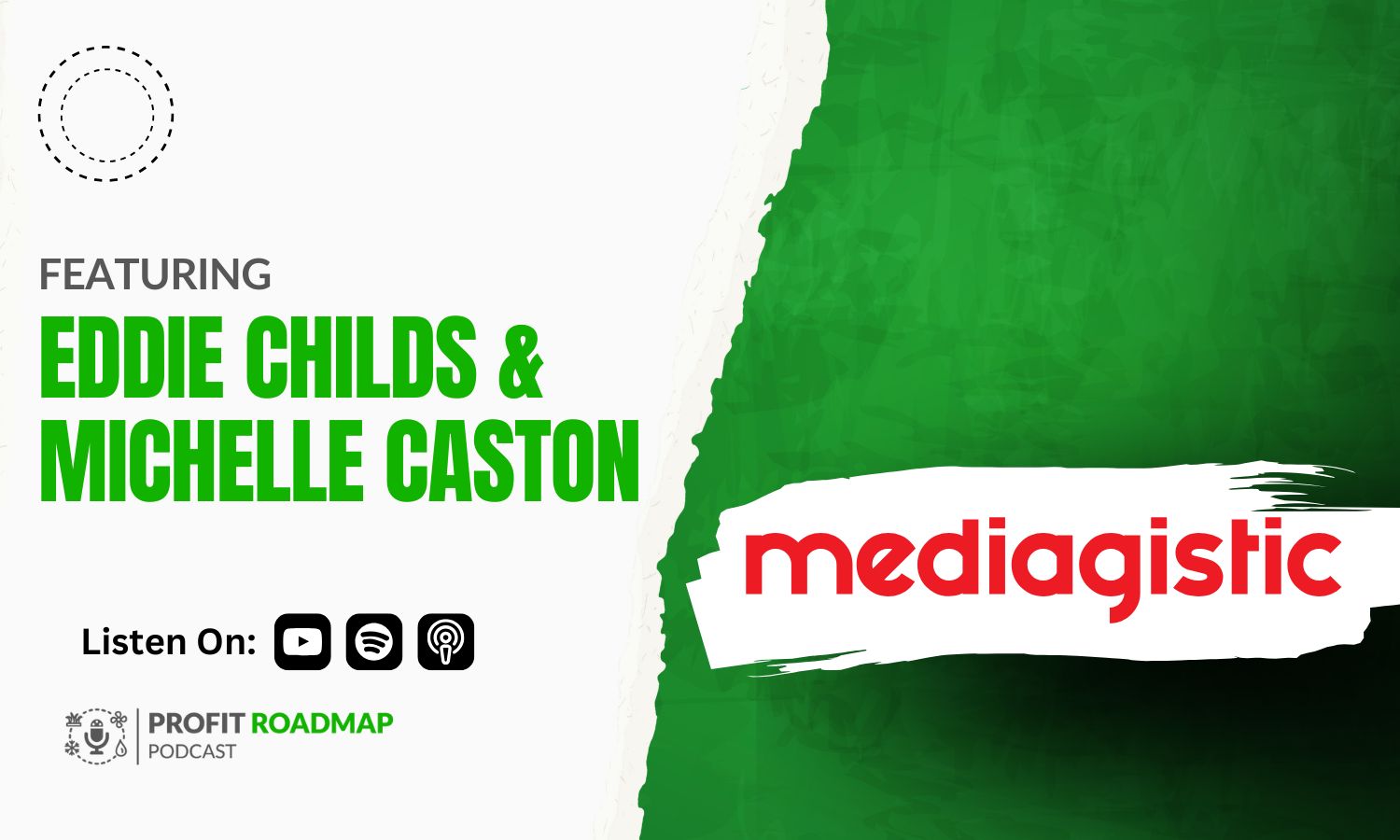On this episode of the Profit Roadmap, we sit down with two experts from Mediagistic: Eddie Childs (Director of Corporate Marketing) and Michelle Caston (Director of Media Planning and Buying), to discuss how field service businesses can stand out in a crowded market and effectively generate leads.
Key Takeaways
- Wrapping your trucks for better visibility
- Staying memorable with consistent branding
- Using strong branding to generate leads
- Focusing on customer experience to drive referrals
- Utilizing marketing automation for better engagement
- Addressing customer pain points with brand storytelling
- Maintaining data hygiene practices for effective marketing campaigns
- Prioritizing a quick-loading, mobile-friendly website
- Enhancing brand identity with custom photography
- Improving customer service efficiency with AI
EPISODE TIMESTAMPS
- [00:00] Intro
- [03:12] Standing Out in a Competitive Market
- [06:02] Brand Consistency
- [08:58] Specific Lead Gen Strategies
- [11:55] Building a Strong Brand Identity
- [14:50] Utilizing Marketing Automation
- [17:48] The Role of Customer Experience
- [21:07] Brand Storytelling Techniques
- [23:52] Leveraging Data for Targeting
- [26:59] Website Essentials
- [29:55] Customer Engagement Strategies
Making a Local Impact
Eddie and Michelle emphasized the importance of making a strong impression at the local level. A key takeaway was the power of wrapping trucks – essentially turning vehicles into rolling billboards that visually speak to your brand. Beyond this, providing an exceptional customer experience is crucial for generating positive word-of-mouth and strong online reviews, which in turn helps businesses get found in local searches. Developing a value-based sales narrative that focuses on what customers truly care about (their homes, families, finances, and time) rather than just the technical aspects of the service was also highlighted as a way to stand out.
Consistency is Key
Michelle stressed the significance of consistent messaging and brand image across all marketing efforts, from broadcast radio and TV spots to websites and physical collateral. Inconsistency can dilute brand recognition and require more exposures for customers to remember a business.
Clever Lead Generation
While transactional lead generation has its place, the experts discussed the benefits of building a strong brand to supplement these efforts. A strong brand can lead to better SEO performance and lower costs for branded keywords in paid search campaigns. They also touched on:
- Outbound sales motions: Converting CSRs to follow up on things like warranty expirations or past service calls to create more opportunities for the sales team.
- Lead gen channels beyond Google: Exploring platforms like Facebook (Meta) lead ads and Yelp leads, noting that while Meta leads require more salesmanship to convert, they can be effective for reaching consumers where they spend a lot of time.
Avoiding Pitfalls and Low-Cost Strategies
When building a brand, Michelle advised against stretching resources too thin. Instead, businesses should concentrate and dominate in a specific area or media channel, building frequency with their target audience before expanding. For low-cost, effective strategies, digital options like digital radio, podcasts, and streaming TV were suggested, allowing for specific targeting by zip code, homeowner status, and income. Eddie added Meta video views ads, Google demand gen ads, and YouTube ads as powerful channels for increasing visibility at a low cost per view.
The Power of Short-Form Video and Educational Marketing
Short-form video on platforms like Instagram Reels and TikTok was identified as a strong play for creating brand awareness, especially for business owners with a good on-camera presence. For those less comfortable on camera, creative alternatives like animated videos or hiring actors can be used. The concept of educational marketing – providing valuable tips and information to consumers for free – was also discussed as a way to build authority and trust, ultimately weeding out DIYers and attracting those who prefer professional help.
Brand Storytelling
Setting your brand apart through storytelling involves identifying your true differentiators beyond the industry’s table stakes (like being family-owned or local). By focusing on the four things customers care about (homes, families, finances, and time) and connecting your service to these, businesses can create a compelling narrative. Making the customer the hero, defining their problems, and presenting your business as the solution with a clear call to action tied to their needs and your value stack (rebatess, warranties, maintenance plans, etc.) are key elements of effective brand storytelling.
Leveraging Data and Marketing Automation
The experts highlighted the importance of a clean and valuable customer database. This first-party data can be used to build custom audiences and lookalike audiences on platforms like social media and streaming digital platforms, allowing for highly targeted marketing campaigns. Marketing automation was emphasized as crucial for retaining customers beyond the initial transaction by using the database to send reminders, offer maintenance plans, and continually earn their business.
Website Essentials
Your website is a critical owned asset. Key ingredients for a website that wows include:
- Fast loading speed and mobile-first design: Consumers won’t wait long for a site to load, and Google prioritizes mobile.
- Custom photography and videos: Differentiating your brand from competitors who use generic stock photos.
- Fluid user experience: Making the phone number and appointment scheduling button easily visible at all times to remove friction.
- Easy-to-read content: Aiming for an eighth-grade reading level to ensure content is scannable and easily digestible for online readers.
Creating Exceptional Customer Experiences
Finally, the conversation circled back to customer experience. The core needs of a customer are simple: they want you to pick up the phone, they want the tech to be on time, they don’t want to feel cheated, and they want their service to work. They also want to feel heard. Removing friction in these areas is key. Examples included using AI voice solutions for phone systems to handle calls efficiently, automating notifications about tech arrival times, using technology on-site to explain recommendations and show value, and monitoring and responding to online reviews to show customers they are heard.
By implementing these strategies, field service businesses can effectively navigate the competitive landscape, build a strong brand, and drive consistent lead generation.
Show Links
- YOUTUBE: https://www.youtube.com/@Mediagistic
- WEBSITE: https://www.mediagistic.com
- FACEBOOK: https://www.facebook.com/mediagistic
- INSTAGRAM: https://www.instagram.com/mediagistic_/
- LINKEDIN: https://www.linkedin.com/company/mediagistic
- TIKTOK: https://www.tiktok.com/@mediagistic
- X: https://x.com/mediagistic



